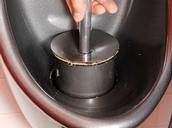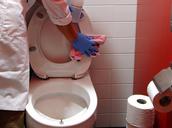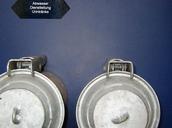Practical guide
Would a NoMix toilet be
a suitable option for me?
NoMix is not yet a
mature technology. Certain elements of the system, such as urine treatment,
have not progressed beyond the laboratory stage. While the sanitary technology
is already available, NoMix toilets do not meet the standard of conventional models
in various respects, and they require careful maintenance. A NoMix toilet
should therefore only be installed after due consideration of all aspects, and the
project objectives should be clearly defined from the outset. The experience
gained from Novaquatis can help to ensure that NoMix installations are properly
planned.
| Text "Practical guide" (pdf, 368 KB) |
Fundamental considerations
(Judit Lienert, Tove A. Larsen)
If you find urine source separation an attractive approach and would like to install NoMix toilets, your intentions are to be applauded! However, in putting your plans into practice, you will need to consider a number of key points, as the technology is still in its infancy. You should have a clear idea of what you are seeking to achieve with NoMix toilets. Does this goal justify the higher costs – and, for example, the significantly greater cleaning efforts required? Urine-diverting toilets do not yet fully meet the standards of today’s conventional lavatories.
One of the main problems is the build-up of urine
scale – leading inevitably to blockages (Nova 2). For this reason, like
waterfree urinals, NoMix toilets need to be well maintained. In addition, many
elements of the NoMix system are not yet fully developed or ready for the
market; for example, a urine treatment process is only offered by a single
company. In Sweden, it is recommended that urine should be stored for six
months for hygienization before being used as a fertilizer. In Switzerland,
however, urine-based fertilizers require approval and have to fulfil stringent requirements.
Novaquatis has accumulated several years' experience
with NoMix pilot projects. This guide provides an overview of the current state
of our knowledge and includes references to key sources (for detailed
information see [1]). It should enable fundamental aspects to be considered at
the planning stage, so that your NoMix project stands the test of everyday life.

"What do I have to do, Mum?" Children in particular
find it difficult to aim correctly
(Photo Ruedi Keller)
Before the start of the project
Objective. The objective of the NoMix pilot project has to be clearly defined in advance. While this sounds trivial, it is crucial to success – the higher-level goals of urine source separation (e.g. reducing nutrient load at wastewater treatment plants, nutrient recycling) are not relevant in an individual project. They are only applicable once a certain critical mass is reached. Realistic objectives may include further development of elements such as urine treatment, or studying the acceptance of NoMix toilets in households.
Early involvement of all stakeholders. Particularly if NoMix toilets are to be installed in private homes, it is essential to involve all parties at a very early stage. Among the important stakeholders are household members, caretakers and property managers, cleaning staff, architects and plumbers, wastewater treatment plant operators, engineers and planners, local officials, authorities, policymakers and scientists. Projects can only succeed if all parties are prepared to accept the drawbacks of the NoMix technology.
Legal aspects, use of urine. As connections to sewers and wastewater treatment plants are mandatory in Switzerland, approval is required for NoMix pilot projects [2 – 3]. A contract should specify who is to assume the risks (malfunctions, accidents) and who is to bear the costs if installations have to be removed. We recommend the conclusion of written agreements with the main parties (e.g. tenants).
The fate of the urine must be determined at the beginning of the project. Fertilizers require approval, which in Switzerland is granted by the Federal Office for Agriculture [4 – 5]. In what is currently the only (provisional) Swiss fertilizer licence for urine – from the BL cantonal library – strict quality requirements are specified (Nova PP). Urine can also be used for nutrient peak shaving at wastewater treatment plants (Nova 3) or for development of treatment processes (Nova 4). If a project is designed, for example, to investigate user attitudes in daily life, urine may also be released into the sewers without being further used (Nova 1).
Technological aspects
NoMix toilets and waterfree urinals. Undiluted urine from men can be collected with the aid of waterfree urinals. A wide variety of systems and models are commercially available [6]. In all cases, urinals need to be carefully maintained to avoid troublesome odours, unsightly stains and blockages. Good ventilation can help to prevent odour problems.
Two flushing systems are used in NoMix toilets [7]: e.g. in Dubbletten the urine compartment is flushed separately with a small amount of water (8 ml – 2 dl). This saves water – provided that users dispose of urine-soiled paper in a bin, rather than using the full flush for this purpose. Although more recent NoMix toilets are fitted with a conventional dual-flush system (small: 2 – 3 l, full: 6 – 7 l), the urine tank receives only a small amount of water (2.5 dl, Gustavsberg) or – thanks to an ingenious closure mechanism – none at all (Roediger). Thus, while these NoMix toilets do not use less water than a modern dual-flush appliance, lightly soiled paper does not have to be disposed of separately.
|
The
disadvantage of the Roediger model is that the urine drain is only opened when
the user is seated. With other models, an accurate aim remains sufficient for male
users – among whom sitting is unpopular. Here, waterfree urinals may offer an alternative.
Women, for their part, are reluctant to sit on public toilets for
hygiene-related reasons. Some users find it difficult to adopt the required sitting
position. Children in particular have problems targeting the right compartment,
which increases the need for cleaning. However, Dubbletten offers a separately
available child seat [7]. Cleaning and maintenance. Broad acceptance can only be gained with sound maintenance. Public sanitary facilities have to be cleaned at least daily. If it is necessary to ensure that no water and only harmless chemicals enter the urine tank, cleaning with, for example, a damp microfibre cloth and a 10% citric acid solution is recommended [1]. One of the main problems affecting NoMix toilets is the build-up of urine scale, which blocks siphons and pipes (Nova 2, [8 – 9]). To prevent the formation of precipitates, the urine drain can be regularly flushed with acid [1]. Blockages can be removed using a strong acid or caustic soda, or by mechanical means [8 – 9]. Certain design measures can help to avoid blockages later on: pipes with the steepest possible slope (at least 2 – 5%), no tight bends or inaccessible sections, and a large diameter (65 – 110 mm) (for further information see [1, 6]). In waterfree urinals, precipitates are frequently collected in siphons, which have to be regularly replaced to avoid drainage problems. Urine storage, transport and treatment. The urine tank should have a capacity appropriate to the requirements of the project, and should be water- and odour-tight and resistant to urine and strong acids. It should have an overflow outlet and possibly also include a stirring mechanism, sampling points and a pump [1, 6]. As urine tanks often emit unpleasant odours, good ventilation is extremely important. For information on urine transport, see Nova 3. A struvite reactor permitting the recovery of phosphorus from urine is available from Huber [10]. All other urine treatment processes are still at the laboratory or pilot stage and await further development (Nova 4). Perhaps this could be an objective of your NoMix project? Urine on tap: At the withdrawal point, urine collected in Forum Chriesbach can be pumped into a tanker as required (Photo Karin Güdel) |

Essential maintenance: To prevent odours and blockages in waterfree urinals, components need to be exchanged in accordance with the manufacturer’s recommendations (Photo Ruedi Keller) 
The right mixture: To clean NoMix toilets without contaminating the urine, one can use a 10% citric acid solution and a microfibre cloth (Photo Ruedi Keller) 
|
Costs
Innovations are always more expensive than tried-and-tested technologies, for which considerable demand – and a large market – already exists. Urine source separation is no exception to this rule. NoMix toilets cost about twice as much as conventional models. Additional costs are associated with urine pipes, tank, transport and treatment. The costs will be further increased if prototypes are required. Accordingly, no information on prices is included here (for an overview, see [6 – 7]).
Conclusions
Although there are good reasons for installing NoMix toilets, anyone intending to launch a project of this kind should be aware that these are pioneering efforts. Compared with conventional options, you should expect higher costs and other drawbacks with NoMix toilets. We wish you every success with your project. Our team will be glad to offer advice, further information and the detailed article [1]: novaquatis@eawag.ch.
References
- Lienert, J., T.A. Larsen (submitted): Pilot projects in bathrooms: a new challenge for wastewater professionals. Available from: novaquatis@eawag.ch.
- Swiss water pollution control bill: Bundesgesetz über den Schutz der Gewässer (24.01.1991). SR-Nr 814.20. Download: http://www.admin.ch/ch/d/sr/c814_20.html, letzter Besuch der Webseite / last visit to website: 30.01.2007, email: webmaster@admin.ch.
- Swiss water pollution control regulation (28.10.1998). SR-Nr 814.201. Download: http://www.admin.ch/ch/d/sr/c814_201.html, letzter Besuch der Webseite / last visit to website: 30.01.2007, email: webmaster@admin.ch.
- Fertilizer book regulation (28.02.2001). SR-Nr 916.171.1. Download: http://www.admin.ch/ch/d/sr/c916_171_1.html, last visit to website: 30.01.2007, email: webmaster@admin.ch.
- Fertilizer regulation (10.01.2001). SR-Nr 916.171. Download: http://www.admin.ch/ch/d/sr/c916_171.html, last visit to website: 30.01.2007, email: webmaster@admin.ch.
- ecosan/GTZ (2005). Technical data sheets for ecosan components. Draft versions available at: www.gtz.de/en/themen/umwelt-infrastruktur/wasser/9397.htm. Deutsche Gesellschaft für Technische Zusammenarbeit (GTZ) GmbH; ecological sanitation (ecosan), last visit to website: 30.01.2007, contact: Christine Werner, ecosan@gtz.de.
- Homepages NoMix WC: www.dubbletten.nu (info@dubbletten.nu), www.wost-man-ecology.se (info@wost-man-ecology.se), www.gustavsberg.com (info@gustavsberg.com), www.roevac.com (info@roevac.com), last visit to websites: 30.01.2007.
- Udert, K.M., R. Högger, T.A. Larsen, W. Gujer (2004) Urinausfällungen in Urinalen und NoMix-Toiletten. Installateur 11-2004: 46–48. Vereinigung Schweizerischer Sanitär- und Heizungsfachleute, VSSH, www.vssh.ch.
- Udert, K.M., T.A. Larsen, W. Gujer (2003) Biologically induced precipitation in urine-collecting systems. Water Science and Technology: Water Supply 3(3): 71–78.
- Hans Huber AG, Berching, Germany. Information: www.huber.de – process engineering –decentralized wastewater treatment – the future begins with ourselves, desar@huber.de, last visit to website: 30.01.2007.


